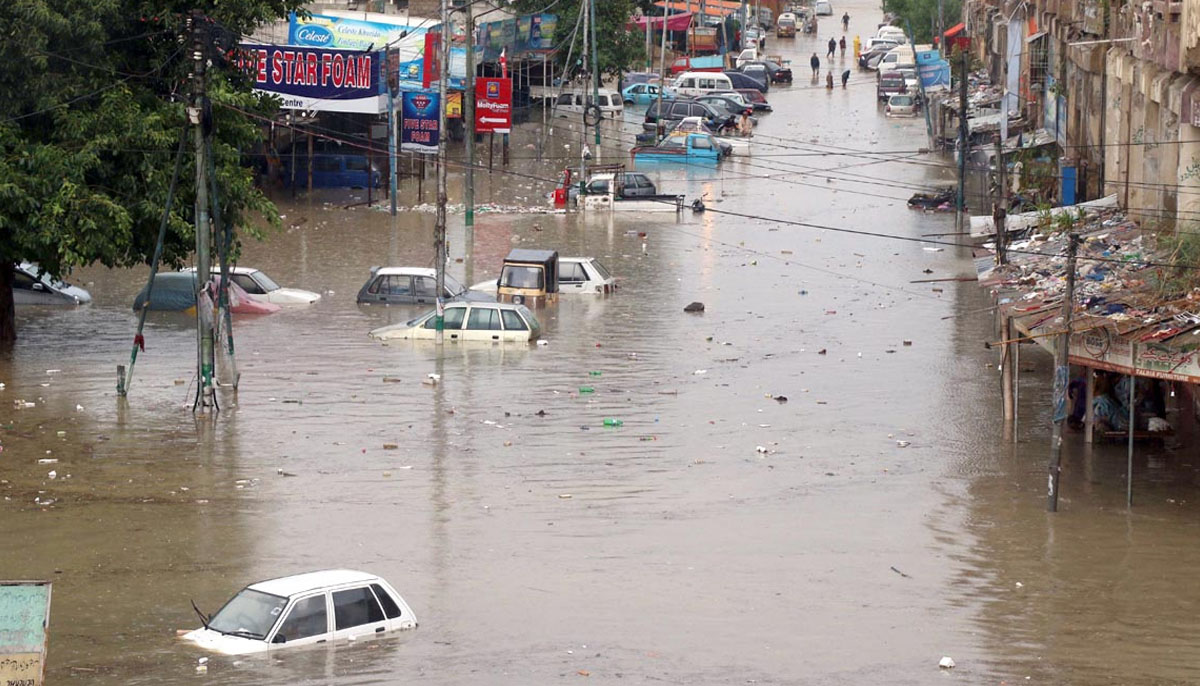Total lack of governance by a govt that has abdicated its responsibility: Karachi requires autonomous LB system to avoid becoming a ghetto
Rains inspire poets, enrich the soul, bring life to dead and desiccated earth, but the clouds, thunder and bolts of light crackling also bring a certain level of anxiety, discomfort and scare for many Karachiites due to the urban flooding that turns large parts of the city into giant cesspools and electrocutions due to snapping wires, reflecting on total lack of governance and a government that has abdicated its responsibility. This is primarily governance and institutional failure from which there can be no respite without a financially autonomous and independent of government LB system and a modern framework of the KWSB.
In the case of Karachi, the urban flooding and waist-deep water is no more limited to the old city areas or only the low lying ones but includes many posh localities, the newly-built roads and underpasses inaugurated with much fanfare that turn into water tunnels or canoe zones.
Many of these have turned into horrific death traps as people or cars are washed down into the storm drains or become victims to snapping wires or unearthed poles. On Sunday, once again tragically four lives were lost following 78mm of rain. This has been the average rainfall in the city since the monsoon began, but the city’s drains are unable to cope with it. People struggling with vehicles in the waist-deep water and abandoning those that break down on the roadside have now common painful site over the years.
The city has over 550 drains of different classifications, but 48 are the major ones, including the Gujjar Lyari, Orangi and Mehmoodabad nullahs. Thinking as if time is a static reality, years of utter disregard and neglect to replace the dilapidated, corroded sewerage lines, overloaded and woefully inadequate to meet the needs of an over populous city add to the woes of the residents in almost every rainy season, signifying the breakdown of governance and institutional failure.
Anticipatory action has never been the hallmark of our provincial government or timely release of funds to unclog the storm drains, months before the onset of the monsoon, which could have given some respite to the residents of the city. But that did not happen despite warnings by the Met Dept of rains causing messy urban flooding — a phenomenon the world has now to live with as climatic changes turn ferocious, vicious and unpredictable and intense with every passing year. The failure to adequately drain the rain ironically has slid Karachi to among the fifth least liveable city in the world, ranking 136th on the list — only managing to fare better than Damascus in Syria, Lagos in Nigeria, Dhaka in Bangladesh and Tripoli in Libya. This has very serious repercussions for business, commerce and foreign investments to continue to flow into the city. Karachi is now at a high risk of natural and human-made disasters and is one of the most disaster-vulnerable districts in Pakistan. The city has an archaic, overloaded and woefully inadequate sewerage system that requires major investments in rehabilitation, network expansion, distribution network and large pumping stations, sewerage projects and revival of the much-delayed Karachi’s greater sewage plan S III. It was revised and was approved by ECNEC at Rs36.11 billion in 2018 and includes the Lyari river basin and Malir river basin.
But at the heart of this are certain stark realities of the fractured local bodies system that remains literally under the thumb of the provincial government, a dysfunctional KWSB, and a KMC that has no control over the DMCs, all in the greater wisdom of the PPP government that resists modification to the 18th Amendment but would resist devolution of the Karachi LB system. Resultantly, the Sindh Solid Waste Management Board has yet to develop a single proper ‘landfill’. The KWSB and KMC and the District Municipal Corporations (DMCs) are supposed to be managing the storm-water drains but their performance leaves much to be desired. They are financially dependent on the provincial government, that gives handouts on a partisan basis that are often delayed and adequate only for non-developmental expenditures like payment of salaries. After Gen Musharraf’s development spree in Karachi, the last time a certain sizeable amount of money was forced out of provincial coffers was courtesy CJP Saqib Nisar who took a suo motu notice to secure budget to clear clogged drains, storm drains and removes encroachments from them. But that was an ad-hoc system. The year 2019 was disastrous again as the CJP Nisar had gone home and now we await the next monsoon spell with a heightened sense of anxiety.
The city needs a highly devolved and financially autonomous and accountable LB system. Radical improvements are required in updating the Provincial Financial Commission and making it available to the local governments. Similarly, modernization of Urban Immovable Property Tax system and its collection system needs to be harnessed to help the city manage some of its basic issues.
While the city needs a lot to be made into livable and a competitive in real terms of a megapolis, but for managing sewage, the KWSB must be allowed to become an autonomous entity which is professionally managed.
It must work to rehabilitate sewerage network, large pumping stations, and development of treatment plants. But none is effectively possible if it remains under the Sindh government, it must be allowed to operate independently like the national and global practice.
Without a financially autonomous city’s LB system, Karachi is likely to slip further down in liveability and could become the world’s largest urban ghetto.
-
 Friends Of Prince William 'aghast' As King Charles Offers Olive Branch To Harry, Meghan Markle
Friends Of Prince William 'aghast' As King Charles Offers Olive Branch To Harry, Meghan Markle -
 What Cancer Does Colleen Hoover Have?
What Cancer Does Colleen Hoover Have? -
 Zayn Malik Drops Special Surprise For Fans On His 33rd Birthday
Zayn Malik Drops Special Surprise For Fans On His 33rd Birthday -
 Nicola Peltz Sends Harsh Message To Beckhams With Brooklyn Comments
Nicola Peltz Sends Harsh Message To Beckhams With Brooklyn Comments -
 Apple Martin 'lashes' Out At Mom Gwyneth Paltrow For Pushing Her 'too Hard'
Apple Martin 'lashes' Out At Mom Gwyneth Paltrow For Pushing Her 'too Hard' -
 Meghan Markle Going To 'humiliate' Prince Harry With UK Trip
Meghan Markle Going To 'humiliate' Prince Harry With UK Trip -
 Pastor Jailed After Secretly Filming Woman In Store
Pastor Jailed After Secretly Filming Woman In Store -
 Julio Iglesias Faces Serious Abuse Accusation
Julio Iglesias Faces Serious Abuse Accusation -
 Buckingham Palace’s ‘liability’ Prince Harry Comes Under Fire: ‘Can Really Harm King Charles’
Buckingham Palace’s ‘liability’ Prince Harry Comes Under Fire: ‘Can Really Harm King Charles’ -
 Emily Bader Reveals Inspiration Behind Choosing Latest Project
Emily Bader Reveals Inspiration Behind Choosing Latest Project -
 Anthropic Rolls Out Claude Cowork For Non-coders
Anthropic Rolls Out Claude Cowork For Non-coders -
 'Tell Me Lies' Creator Meaghan Oppenheimer Breaks Silence On Season 3 Rumor
'Tell Me Lies' Creator Meaghan Oppenheimer Breaks Silence On Season 3 Rumor -
 Prince Harry's Friend Rubs Shoulders With Mike Tindall And Zara
Prince Harry's Friend Rubs Shoulders With Mike Tindall And Zara -
 Google Rolls Out First Android Update Of 2026 To Pixel Phones
Google Rolls Out First Android Update Of 2026 To Pixel Phones -
 Matt Damon Reveals Wife Luciana Barroso Found Ben Affleck THIS In 'Good Will Hunting'
Matt Damon Reveals Wife Luciana Barroso Found Ben Affleck THIS In 'Good Will Hunting' -
 Aurora Alert: Northern Lights Visible Tonight At High Latitudes
Aurora Alert: Northern Lights Visible Tonight At High Latitudes




